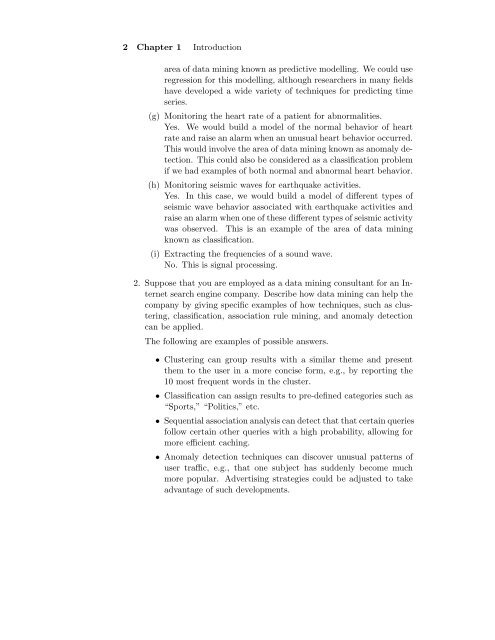Introduction To Data Mining Instructor's Solution Manual
Introduction To Data Mining Instructor's Solution Manual
Introduction To Data Mining Instructor's Solution Manual
Create successful ePaper yourself
Turn your PDF publications into a flip-book with our unique Google optimized e-Paper software.
2 Chapter 1 <strong>Introduction</strong><br />
area of data mining known as predictive modelling. We could use<br />
regression for this modelling, although researchers in many fields<br />
have developed a wide variety of techniques for predicting time<br />
series.<br />
(g) Monitoring the heart rate of a patient for abnormalities.<br />
Yes. We would build a model of the normal behavior of heart<br />
rate and raise an alarm when an unusual heart behavior occurred.<br />
This would involve the area of data mining known as anomaly detection.<br />
This could also be considered as a classification problem<br />
if we had examples of both normal and abnormal heart behavior.<br />
(h) Monitoring seismic waves for earthquake activities.<br />
Yes. In this case, we would build a model of different types of<br />
seismic wave behavior associated with earthquake activities and<br />
raise an alarm when one of these different types of seismic activity<br />
was observed. This is an example of the area of data mining<br />
known as classification.<br />
(i) Extracting the frequencies of a sound wave.<br />
No. This is signal processing.<br />
2. Suppose that you are employed as a data mining consultant for an Internet<br />
search engine company. Describe how data mining can help the<br />
company by giving specific examples of how techniques, such as clustering,<br />
classification, association rule mining, and anomaly detection<br />
can be applied.<br />
The following are examples of possible answers.<br />
• Clustering can group results with a similar theme and present<br />
them to the user in a more concise form, e.g., by reporting the<br />
10 most frequent words in the cluster.<br />
• Classification can assign results to pre-defined categories such as<br />
“Sports,” “Politics,” etc.<br />
• Sequential association analysis can detect that that certain queries<br />
follow certain other queries with a high probability, allowing for<br />
more efficient caching.<br />
• Anomaly detection techniques can discover unusual patterns of<br />
user traffic, e.g., that one subject has suddenly become much<br />
more popular. Advertising strategies could be adjusted to take<br />
advantage of such developments.


